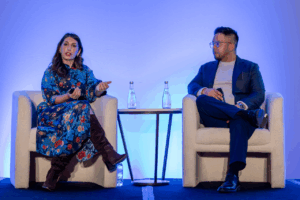 “Data-Driven Thinking” is a column written by members of the media community and containing fresh ideas on the digital revolution in media.
“Data-Driven Thinking” is a column written by members of the media community and containing fresh ideas on the digital revolution in media.
Today’s column is written by Rob Schmults, SVP Strategic Partnerships, Intent Media, an online ad platform for ecommerce publishers.
“Intent Marketing” – matching offers (and a little later in history, ads) to the specific intent expressed by a consumer – probably dates back to the first merchant who noticed a customer eyeing a product and stepped in to help her decide. “Yes, those are lovely figs. But perhaps you might be interested in these? They just came in on this morning’s caravan…”
“Contemporary Intent Marketing” – showing an ad to a site visitor that corresponds to demonstrated intent – is most manifest in the form of search engine marketing. But as it spreads beyond sites like Google, it’s probably worth taking a moment to define what intent marketing is. And what it isn’t.
For intent marketing to work optimally, three attributes must simultaneously be present. It’s consumer driven (what intent are they expressing?). It’s specific (the ad/offer matches the expressed intent). And it’s immediate (the expressed intent and the ad/offer happen concurrently).
It’s the combination of all three attributes that make intent marketing so powerful. You’ve got an ad that is triggered in response to a specific consumer request (“I want a flight from NYC to Dallas”), one that matches that request (“see flights from NYC to Dallas on Hotwire”), and does so exactly when the consumer is saying they are interested in seeing it. It’s the very literal fulfillment of the old mantra of right product, right place, right time.
Done right, the results can be substantially better than targeting based on passive observation of a user’s navigation such as behavioral targeting or stitching together conclusions based on social patterns. This because when the consumer takes an action beyond simply visiting a page, an action that shows intent to learn more about or purchase something – such as choosing a flight or sizing a garment- it is a clearer indicator of interest and one that can be addressed with an immediacy not possible with most other ad formats.
This is not to say behavioral targeting is bad. BT and its various forms have revolutionized the display ad space. The ability to target (or retarget) based on what a given user has done recently, ether via a single signal or multiple inputs, has given advertisers a valuable capability to more efficiently and effectively spend their display budgets. Although BT taps into observed intent, it happens after the fact and often is not specific (e.g., I looked for a flight to NYC, and later I get shown a NYC hotel offer). Part of the attraction of behavioral targeting is precisely because of its differences from intent marketing. I can go after segments, I can go after clusters of signals, etc. downstream of where intent marketing typically occurs.
And while social marketing practitioners are still looking for the secret sauce on how to drive transactions from the social graph, it’s again likely the differences from intent marketing will hold its unique value. With enough heavy lifting on the data front, inevitably more and more clarity will emerge as to how people’s interactions and connections exert influence on purchases. Given the potential challenges in targeting ads based on social activity (which is usually inherently non-transactional) and the dissonance around timing (social times are not typically transactional), it seems likely marketing opportunities that emerge will be upstream from where intent marketing occurs.
As intent marketing online moves increasingly beyond the confines of search, the attempts to appropriate the concept as a variant of behavioral targeting, social marketing, or other approaches risks confusing advertisers and are ultimately self defeating. Notions like “The Intent Graph” or “Intent Retargeting” (to pick a couple popping up recently) blur intent marketing with other models. Doing so makes it harder for marketers to move forward when they need to untangle one from the other to properly use either. It would be a shame if the industry rush to embrace the notion of intent marketing actually ends up stunting its growth.
Follow Intent Media (@intentmedia) and AdExchanger.com (@adexchanger) on Twitter.











